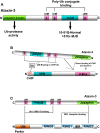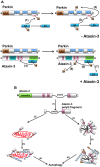Ataxin-3 and its e3 partners: implications for machado-joseph disease
- PMID: 23653622
- PMCID: PMC3644722
- DOI: 10.3389/fneur.2013.00046
Ataxin-3 and its e3 partners: implications for machado-joseph disease
Abstract
Machado-Joseph disease (MJD) is the most common dominant inherited ataxia worldwide, caused by an unstable CAG trinucleotide expansion mutation within the SCA3 gene resulting in an expanded polyglutamine tract within the ataxin-3 protein. Ataxin-3 functions as a deubiquitinating enzyme (DUB), within the Ub system and whilst many DUBs are known to partner with and deubiquitinate specific E3-Ub ligases, ataxin-3 had no identified E3 partner until recent studies implicated parkin and CHIP, two neuroprotective E3 ligases. MJD often presents with symptoms of Parkinson disease (PD), which led to identification of parkin as a novel E3-Ub ligase whose activity was regulated by ataxin-3-mediated deubiquitination. Findings from these studies also revealed an unexpected convergence upon the E2-Ub-conjugating enzyme in the regulation of an E3/DUBenzyme pair. Moreover, mutant but not wild-type ataxin-3 promotes the clearance of parkin via the autophagy pathway, raising the intriguing possibility that increased turnover of parkin may contribute to the pathogenesis of MJD and help explain some of the Parkinsonian features in MJD. In addition to parkin, the U-box E3 ligase CHIP, a neuroprotective E3 implicated in protein quality control, was identified as a second E3 partner of ataxin-3, with ataxin-3 regulating the ability of CHIP to ubiquitinate itself. Indeed, ataxin-3 not only deubiquitinated CHIP, but also trimmed Ub conjugates on CHIP substrates, thereby regulating the length of Ub chains. Interestingly, when expanded ataxin-3 was present, CHIP levels were also reduced in the brains of MJD transgenic mice, raising the possibility that loss of one or both E3 partners may be a contributing factor in the pathogenesis of SCA3. In this review we discuss the implications from these studies and describe the importance of these findings in helping us understand the molecular processes involved in SCA3 and other neurodegenerative disorders.
Keywords: CHIP; Machado–Joseph disease; Parkinson’s disease; ataxin-3; parkin; polyglutamine expansion.
Figures


Similar articles
-
The deubiquitinase function of ataxin-3 and its role in the pathogenesis of Machado-Joseph disease and other diseases.Biochem J. 2024 Mar 20;481(6):461-480. doi: 10.1042/BCJ20240017. Biochem J. 2024. PMID: 38497605 Free PMC article. Review.
-
The Machado-Joseph disease-associated mutant form of ataxin-3 regulates parkin ubiquitination and stability.Hum Mol Genet. 2011 Jan 1;20(1):141-54. doi: 10.1093/hmg/ddq452. Epub 2010 Oct 11. Hum Mol Genet. 2011. PMID: 20940148 Free PMC article.
-
Ataxin-3 deubiquitination is coupled to Parkin ubiquitination via E2 ubiquitin-conjugating enzyme.J Biol Chem. 2012 Jan 2;287(1):531-541. doi: 10.1074/jbc.M111.288449. Epub 2011 Nov 11. J Biol Chem. 2012. PMID: 22081612 Free PMC article.
-
The parkin V380L variant is a genetic modifier of Machado-Joseph disease with impact on mitophagy.Acta Neuropathol. 2024 Aug 1;148(1):14. doi: 10.1007/s00401-024-02762-6. Acta Neuropathol. 2024. PMID: 39088078 Free PMC article.
-
Toward therapeutic targets for SCA3: Insight into the role of Machado-Joseph disease protein ataxin-3 in misfolded proteins clearance.Prog Neurobiol. 2015 Sep;132:34-58. doi: 10.1016/j.pneurobio.2015.06.004. Epub 2015 Jun 27. Prog Neurobiol. 2015. PMID: 26123252 Review.
Cited by
-
The deubiquitinase function of ataxin-3 and its role in the pathogenesis of Machado-Joseph disease and other diseases.Biochem J. 2024 Mar 20;481(6):461-480. doi: 10.1042/BCJ20240017. Biochem J. 2024. PMID: 38497605 Free PMC article. Review.
-
Autophagy mediates SUMO-induced degradation of a polyglutamine protein ataxin-3.Anim Cells Syst (Seoul). 2017 May 25;21(3):169-176. doi: 10.1080/19768354.2017.1330765. eCollection 2017. Anim Cells Syst (Seoul). 2017. PMID: 30460066 Free PMC article.
-
Polyglutamine spinocerebellar ataxias - from genes to potential treatments.Nat Rev Neurosci. 2017 Oct;18(10):613-626. doi: 10.1038/nrn.2017.92. Epub 2017 Aug 17. Nat Rev Neurosci. 2017. PMID: 28855740 Free PMC article. Review.
-
Ubiquitin Carboxyl-Terminal Hydrolases (UCHs): Potential Mediators for Cancer and Neurodegeneration.Int J Mol Sci. 2020 May 30;21(11):3910. doi: 10.3390/ijms21113910. Int J Mol Sci. 2020. PMID: 32486284 Free PMC article.
-
Trinucleotide repeats: a structural perspective.Front Neurol. 2013 Jun 20;4:76. doi: 10.3389/fneur.2013.00076. eCollection 2013. Front Neurol. 2013. PMID: 23801983 Free PMC article.
References
LinkOut - more resources
Full Text Sources
Other Literature Sources

